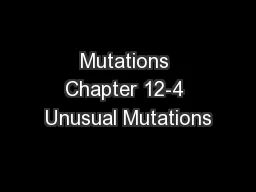

httpio9gizmodocom10unusualgeneticmutationsinhumans470843733 Unharmful Mutations Mila Kunis has complete heterochromia Kate Bosworth has sectoral heterochromia Angelina Jolie has central ID: 737250
Download Presentation The PPT/PDF document "Mutations Chapter 12-4 Unusual Mutations" is the property of its rightful owner. Permission is granted to download and print the materials on this web site for personal, non-commercial use only, and to display it on your personal computer provided you do not modify the materials and that you retain all copyright notices contained in the materials. By downloading content from our website, you accept the terms of this agreement.
Slide1
Mutations
Chapter 12-4Slide2
Unusual Mutations
http://io9.gizmodo.com/10-unusual-genetic-mutations-in-humans-470843733Slide3
Unharmful Mutations
Mila
Kunis
has complete
heterochromia
. Kate Bosworth has
sectoral
heterochromia
. Angelina Jolie has central
heterochromia
.Slide4
What are mutations?
Any change to the genetic code
Gene mutations:
A change in one or a few nucleotides in a gene
Chromosomal Mutations:
a change in the number or structure of chromosomesSlide5
What are mutations?
Gene mutations:
1) Substitution:
C
hange of one nucleotide in the genetic sequence. Will change that specific codon.
2)
Frameshift
: Shift in the reading frame of nucleotides that may cause every codon after the mutation to be different.
Insertion or deletion Slide6
What are mutations?
Chromosomal mutations:
A change in one or a few chromosomes
4 Types:
1)
Deletion
: Loss of part / all
2)
Duplication
: Segment is repeated
3)
Inversion
:
Segment is
reversed
4)
Translocation
:
Segment
breaks off and is reattachedSlide7
Gene mutation: SubstitutionSlide8
Gene Mutation: Deletion or Insertion?Slide9
Gene Mutation:
Insertion
DeletionSlide10Slide11
Mutation vs. variation
It’s important to remember that losing the function of a gene doesn’t always affect health. For example, most mammals have hundreds of genes that code for olfactory receptors, proteins that help us smell. Losing one of these genes probably doesn’t make all that much difference.
In contrast to variations that cause disease, there are many more examples of variations that are neither good nor bad, but just different—like blood types and eye color. Just like with disease alleles, the process of mutation creates these more neutral variations. But with neutral variations, it can be impossible to tell which allele is the "normal" one that existed first and which is the "mutant"—and the distinction is often meaningless.
http://
learn.genetics.utah.edu
/content/variation/mutation/Slide12
Good mutations?
http://
www.xovain.com
/how-to/7-beautiful-mutations-which-ones-do-you-haveSlide13
Amoeba Sisters
https://
www.youtube.com
/
watch?v
=GieZ3pk9YVo